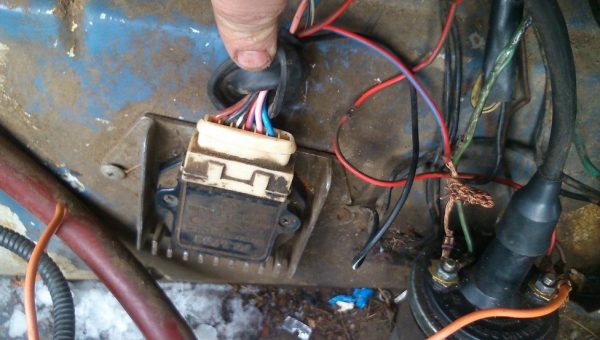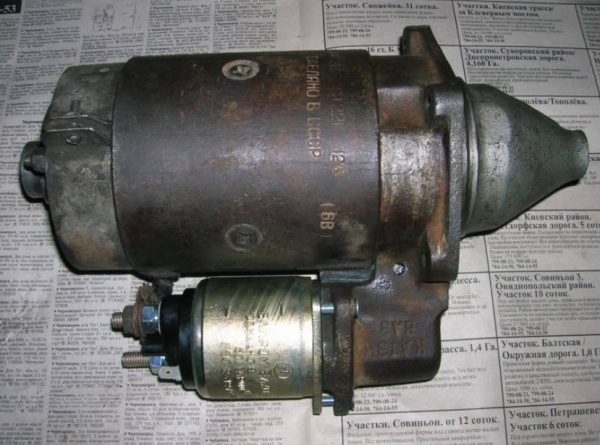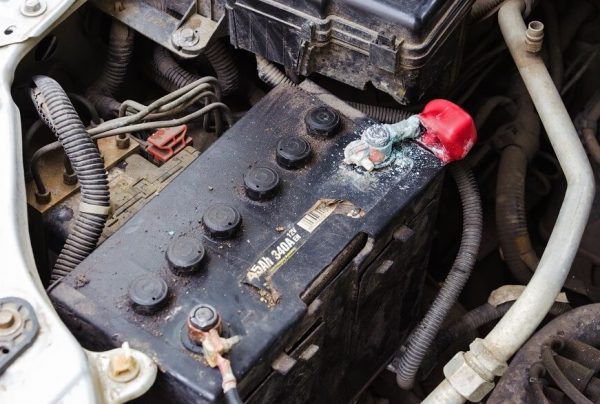
We independently determine why the VAZ 2106 engine does not start
Content
Surely any owner of the VAZ 2106 faced a situation where, after turning the ignition key, the engine did not start. This phenomenon has a wide variety of reasons: from problems with the battery to problems with the carburetor. Let's analyze the most common reasons why the engine does not start, and think about eliminating these malfunctions.
Starter does not turn
The most common reason why the VAZ 2106 refuses to start is usually related to the starter of this car. Sometimes the starter categorically refuses to rotate after turning the key in the ignition. This is why it happens:
- the battery is discharged. The first thing that an experienced owner of the "six" checks is the condition of the battery. To do this is very simple: you need to turn on the low beam headlights and see if they shine brightly. If the battery is heavily discharged, the headlights will shine very dimly, or they will not shine at all. The solution is obvious: remove the battery from the car and charge it with a portable charger;
- one of the terminals is oxidized or poorly screwed. If there is no contact in the battery terminals or this contact is very weak due to oxidation of the contacting surfaces, the starter will also not rotate. At the same time, the low beam headlights can shine normally, and all the lights on the instrument panel will burn properly. But to scroll the starter, the charge is not enough. Solution: after each unscrewing of the terminals, they should be thoroughly cleaned with fine sandpaper, and then a thin layer of lithol should be applied to the contact surfaces. This will protect the terminals from oxidation, and there will be no more problems with the starter;
 The motor may not start due to oxidation of the battery terminals.
The motor may not start due to oxidation of the battery terminals. - the ignition switch has failed. Ignition locks in the "sixes" have never been very reliable. If no problems were found during the inspection of the battery, it is likely that the cause of problems with the starter is in the ignition switch. Checking this is easy: you should disconnect a couple of wires going to the ignition and close them directly. If after that the starter starts to rotate, then the source of the problem has been found. Ignition locks cannot be repaired. So the only solution is to unscrew a couple of bolts that hold this lock and replace it with a new one;
 Ignition locks on the "sixes" have never been reliable
Ignition locks on the "sixes" have never been reliable - the relay has broken. Finding out that the problem is in the relay is not difficult. After turning the ignition key, the starter does not rotate, while the driver hears quiet, but quite distinct clicks in the cabin. The health of the relay is checked as follows: the starter has a pair of contacts (those with nuts). These contacts should be closed with a piece of wire. If the starter then began to rotate, the solenoid relay should be changed, since it is simply impossible to repair this part in a garage;
 When checking the starter, the contacts with the nuts are closed with a piece of insulated wire
When checking the starter, the contacts with the nuts are closed with a piece of insulated wire - The starter brushes are worn out. The second option is also possible: the brushes are intact, but the armature winding was damaged (usually this is due to the closure of adjacent turns from which the insulation was shed). In both the first and second cases, the starter will not make any sounds or clicks. To establish that the problem is in the brushes or in damaged insulation, the starter will have to be removed and disassembled. If the "diagnosis" is confirmed, you will have to go to the nearest auto parts store for a new starter. This device cannot be repaired.
 To check the condition of the brushes, the starter "six" will have to be disassembled
To check the condition of the brushes, the starter "six" will have to be disassembled
Learn more about starter repair: https://bumper.guru/klassicheskie-modeli-vaz/elektrooborudovanie/starter-vaz-2106.html
Video: a common problem with the starter on the "classic"
Starter turns but no flashes
The next typical malfunction is the rotation of the starter in the absence of flashes. Here are some reasons why this might happen:
- broken timing belt. The first thing the owner of the VAZ 2106 should do, noticing the rotation of the starter without flashes, is to check the integrity of the timing belt. It's simple: the starter rotates properly, but the torque is not transmitted to the crankshaft, since there is simply nothing to transmit it with, since the timing belt broke (or flew off the guides - this also happens if the belt is worn out and begins to sag). The solution is obvious: the timing belt will have to be changed;

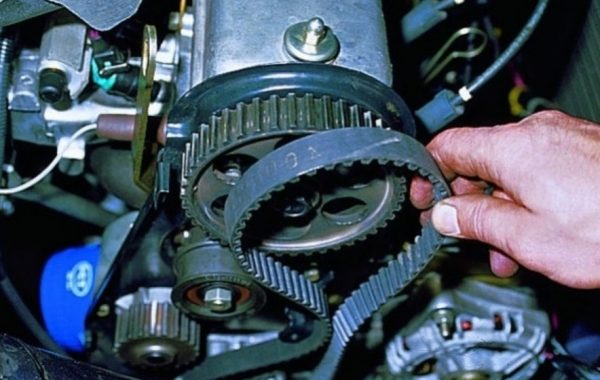 Sometimes for a normal start of the engine on the "six" you have to change the timing belt
Sometimes for a normal start of the engine on the "six" you have to change the timing belt - problem with spark plugs and fuel pump. This is the second reason for the absence of flashes when the starter is spinning. The candles are checked as follows: the ignition key is turned, the starter makes five to seven turns, after which the key is removed from the lock. Then the candles are unscrewed in turn and inspected. If, after a long rotation of the starter, all the candles remain completely dry, then this indicates that the fuel mixture does not enter the combustion chamber. And this means that the problem may be in a broken fuel pump. Checking it is not difficult: you just need to turn the key in the ignition and listen. The working fuel pump emits a characteristic buzzing sound. And if only the sound of the starter is heard, but there is no buzzing, the fuel pump will have to be changed;

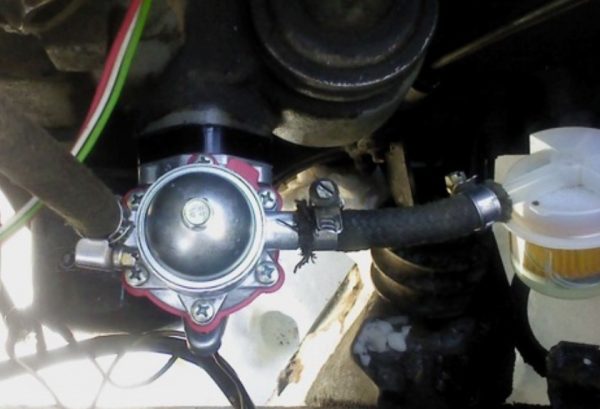 If the fuel pump does not work properly, the fuel supply to the engine is disrupted and it will not start.
If the fuel pump does not work properly, the fuel supply to the engine is disrupted and it will not start. - The fuel pump is fine, but the car still won't start. After unscrewing the candles, the car owner sees that they are all wet. In this case, you should take the spark plug by the insulated part, touch the spark plug to the motor and ask your partner to get into the cab and turn the starter several times. If there is no spark between the contacts of the candle, it is time to replace it.

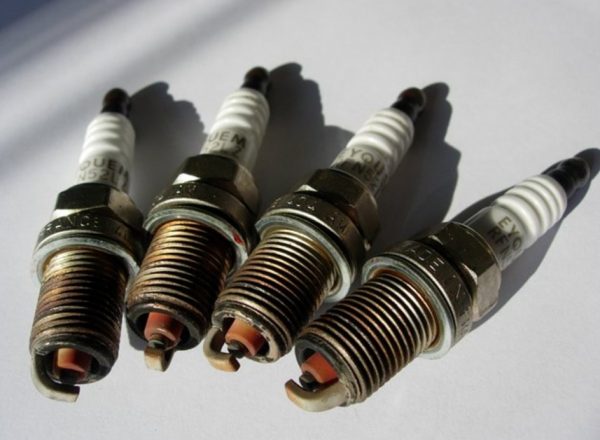 VAZ 2106 may not start due to problems with spark plugs. Then all the candles are replaced with new ones.
VAZ 2106 may not start due to problems with spark plugs. Then all the candles are replaced with new ones.
Read about the timing chain drive device: https://bumper.guru/klassicheskie-modeli-vaz/grm/kak-vystavit-metki-grm-na-vaz-2106.html
The starter works, the engine starts and immediately stalls
In some situations, the car owner cannot start the engine of his "six" even if the starter is working properly. It looks like this: after turning the ignition key, the starter makes two or three turns, the engine "grabs", but literally in a second it stalls. This happens because of this:
- the fuel pump is not working properly. The situation is simple: very little fuel is supplied to the combustion chamber, and literally after one engine cycle, the supply of the fuel mixture stops. There is only one way out: remove the pump, disassemble it and carefully inspect it for wear and mechanical damage. If the problem is really in it - change it;
- the fuel line is clogged. This is another reason why little fuel mixture enters the combustion chambers of the "six". It's no secret that the quality of gasoline in our country leaves much to be desired. Modern gasoline contains a lot of impurities that are gradually deposited on a variety of surfaces - from the inner walls of combustion chambers to fuel pipes. If the fuel pump and starter are working properly, but the car still won't start, then it's time to remove and clean the fuel line. This is best done with ordinary kerosene;
- clogging of one or more nozzles. If checking the fuel pump and fuel pipes did not lead to anything, there is one more option left: unscrew and check the injectors. They clog all because of the same low-quality gasoline. And in case of clogging, everything is washed in the same kerosene;
- closure of the armored line. If no problems were identified with the fuel supply system, and the car still does not start, you should pay attention to the ignition system, and in particular, to the so-called armored wires. If the integrity of the insulation of one or more wires is broken, and the insulation at the site of damage turns black, then there is a short circuit. A candle with a damaged wire cannot produce a spark normally, as a result, the engine stalls, barely having time to start. There is only one way out of this situation: buying and installing a new set of spark plug wires;

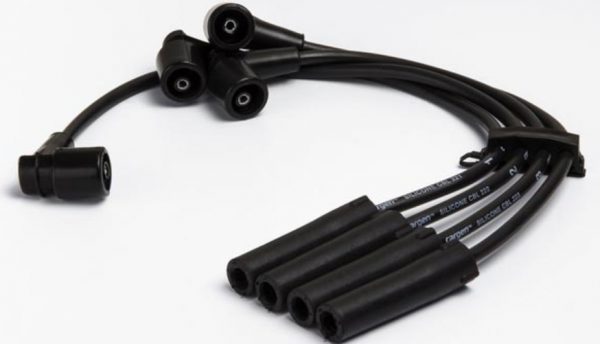 If at least one high-voltage wire breaks down, you will have to buy a new set
If at least one high-voltage wire breaks down, you will have to buy a new set - timing belt shift. The timing belt, like all other parts of the "six" engine, wears out over time. Sometimes it happens that it jumps off the timing shaft gear and shifts a couple of teeth. As a result, the timing of the valve timing is disturbed and the engine does not start. If there is a suspicion of belt displacement, the driver will have to unscrew the timing cover (it is held on by six bolts) and inspect the shafts. The worn belt is replaced with a new one, after which the timing phases are adjusted. You can learn how this is done from the instruction manual for the VAZ 2106.

 The timing belt on the VAZ 2106 can fly off or move a few teeth, which will cause the timing shift
The timing belt on the VAZ 2106 can fly off or move a few teeth, which will cause the timing shift
Video: poor engine start in the summer due to the accumulation of gasoline fumes


Watch this video on YouTube
Poor start of the VAZ 2107 engine in the cold season
Almost all the problems with the VAZ 2106 engine listed above are typical for the warm season. The poor start of the "six" engine in winter should be discussed separately. The main reason for this phenomenon is obvious: frost. Due to the low temperature, the engine oil thickens, as a result, the starter simply cannot crank the crankshaft at a high enough speed. In addition, the oil in the gearbox also thickens. Yes, at the time of starting the engine, the car is usually in neutral gear. But on it, the shafts in the gearbox also rotate by the engine. And if the oil thickens, these shafts create a load on the starter. To avoid this, you need to fully depress the clutch at the time of starting the engine. Even if the car is in neutral. This will relieve the load on the starter and speed up the start of a cold engine. There are a number of typical problems due to which the engine cannot start in cold weather. Let's list them:
- bad compression in the engine. This problem is very often observed in old "sixes" with high mileage: the compression in the cylinders in the cold becomes very low. Not only is compression low, but it can also be different. For example, in two cylinders it is normal, in the other two - reduced. If the driver has found out that the reason for the poor start of the engine is precisely in low compression, and you need to start the car urgently, then you should unscrew all the candles and add a little engine oil to the combustion chambers (it is better to do this with a syringe - five "cubes" of oil in each cylinder will be sufficient). After that, turn the starter of the car several times without screwing in the candles. Then the spark plugs are screwed into place and the engine starts, because the engine oil significantly increases the compression in the cylinders (albeit not for long). And for the final elimination of the problem, an overhaul of the engine should be carried out. And in particular - the replacement of piston rings. Without this, normal compression in the cylinders cannot be restored. There is another way to start a hopelessly frozen car: use the so-called starting fluid. It is sold at auto parts stores. It is injected directly into the carburetor (for this, the air filter cover will have to be unscrewed). And if there is no desire to mess around with the filter cover in the cold, you can unscrew the candles and inject liquid into the combustion chambers. This is also an option, although not as effective;

 Starting fluid helps to start even a completely frozen car
Starting fluid helps to start even a completely frozen car - bad spark. If in summer this moment on the “six” does not prevent the driver from starting the engine, then in winter the situation can change dramatically. Most often, the problem occurs due to poor contact in various plugs, especially those located on the ignition coil and on the distributor. The fact is that the plugs on these parts very often oxidize, and this causes a decrease in the strength of the spark. Understanding how strong a spark is is very simple. The main wire is removed from the distributor and brought to the valve cover at a distance of one centimeter. After securing the wire in this position, turn the starter several times. If a spark at a distance of one centimeter breaks through to the valve cover, then everything is in order with it. If not, you should carefully check all plugs and contacts for oxidation.

 It is best to hold the candle when checking the strength of the spark with pliers with insulated handles.
It is best to hold the candle when checking the strength of the spark with pliers with insulated handles.
Claps when starting the VAZ 2106 engine
Claps when starting the engine is another unpleasant phenomenon that every owner of the "six" faces sooner or later. Moreover, the car can “shoot” both in the muffler and in the carburetor. Let's consider these points in more detail.
Pops in the muffler
If the “six” “shoots” into the muffler when starting the engine, it means that the gasoline entering the combustion chambers has completely flooded the spark plugs. Fixing the problem is quite simple: it is necessary to remove the excess fuel mixture from the combustion chambers. To do this, when starting the engine, depress the gas pedal to the stop. This will lead to the fact that the combustion chambers are quickly blown and the engine starts without unnecessary pops.


More about the muffler VAZ 2106: https://bumper.guru/klassicheskie-modeli-vaz/dvigatel/muffler-vaz-2106.html
The problem is especially relevant in winter, when starting "on a cold". After a long period of inactivity, the engine needs to warm up properly, and it does not need a too rich fuel mixture. If the driver forgets about this simple circumstance and does not reset the suction, then the candles are filled in and pops inevitably appear in the muffler.
Pops in the carburetor
If, when starting the engine, pops are heard not in the muffler, but in the VAZ 2106 carburetor, then this indicates that the suction is not working properly. That is, the working mixture entering the combustion chambers of the cylinders is too lean. Most often, the problem occurs due to too much clearance in the carburetor air damper.


This damper is actuated by a special spring-loaded rod. The spring on the stem may weaken or simply fly off. As a result, the damper stops tightly closing the diffuser, which leads to a depletion of the fuel mixture and subsequent “shooting” in the carburetor. Finding out that the problem is in the damper is not difficult: just unscrew a couple of bolts, remove the air filter cover and look into the carburetor. To understand that the air damper is well spring-loaded, just press on it with your finger and release. After that, it should quickly return to its original position, completely blocking the access of air. There should not be any gaps. If the damper does not adhere tightly to the walls of the carburetor, then it is time to change the damper spring (and it will have to be changed along with the stem, since these parts are not sold separately).
Video: cold start of the VAZ 2106 engine


Watch this video on YouTube
So, there are a great many reasons why the "six" may refuse to start. It is not possible to list them all within the framework of one small article, however, we have analyzed the most common reasons. The vast majority of problems that interfere with the normal start of the engine, the driver can fix it on his own. To do this, you need to have at least an elementary idea of \u2106b\uXNUMXbthe operation of a carburetor internal combustion engine installed on a VAZ XNUMX. The only exception is the case with reduced compression in the cylinders. To eliminate this problem without the help of qualified auto mechanics, alas, it is impossible to do.



